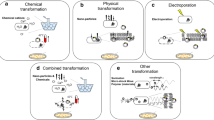Summaby
By serial transfers of the lysogenic strainEscherichia coli K 12 on media containing increasing concentrations of potassium cyanide it was possible to. obtain variants resistant to 0.4M-KCN. The resistant strains obtained preserve their resistance even during serial transfers on media without cyanide. The acquisition of resistance to cyanide was accompanied in these strains by changes in certain properties as compared with the original strain. Some of them were reversible, some, especially the biochemical changes, altered sensitivity to phages and devious production of phage, remained stable even after 50 transfers on media without cyanide. With the aid of the phage released by the strain K 12, resistant to 0.4M-KCN, it was possible to transduce not only the resistance to cyanide but also the loss of sensitivity to the T phages and the loss of ability to ferment dulcitol. The linkage of these properties, however, was never complete as the transduced resistance to cyanide was somewhat lower than the original (0.3M instead of 0.4M) and the bacteria transduced did not produce only the a phage as the donor strain but predominantly the original phage.
Abstract
Путем пассажей лизогенного штамма Escherichia coli K 12 на средах, содержавших повышающиеся кондентрадии дианистого калия, удалось вырастить варианты, резистентные к 0,4 мол. Кондент KCN. Полученные резистентые штаммы сохраняют свою резистентность и при пассажах на средах без дианистого калия. С приобретением устойчивости к дианистому калиию у этих штаммов изменились и другие свойства в сравнении с исходным штаммом. Некоторые изменения оказались обратимыми, другие, — как биохимические изменения, изменения чувствительности к ϕагам и в продукции ϕага, — сохранялись стабильно и после 50 пассажей на средах без цианистого калия. С помощью ϕага, выделенного из штамма К 12, устойчивого к 0,4 мол. концентрации цианистого калия, удалась трансдукция не только устойчивости к цианистому калию, но одновременно и чувствительности к ϕагам группы coli Т и утраты способности сбраживать дульцит. Однако связь между этими особенностями не была стопроцентной, так как перенесенная устойчивость к дианистому калию оказалась несколько более низкой, чем исходная (0,3 мол. Вместо 0,4 мол.), а бактерии после трансдукдии продуцировали не только ϕаг α, как бактериидоноры, но и преимущественно первоначальный ϕаг.
Similar content being viewed by others
References
Adams, M. H.:Methods of study of bacterial viruses Meth. Med. Res. 2: 1, 1950.
Bail, O.:Versuche über die Vielheit von Bakteriophagen. Z. Immun. Forsch. 38: 57, 1923.
Bailey, W. R.:Studies on the transduction phenomenon. II. The occurrence of Salmonella transducing phages in nature. Can. J. Microbiol. 2: 555, 1956.
Bertani, G.:Lysogenic versus lytic cycle of phage multiplication. Cold Spring Harbor Symp. Quant. Biol. 18: 65, 1953.
Burnet, F. M., Koegh, C. V., Lush, D.:The immunological reactions of bacteriophages. Aust. J. exp. Biol. med. Sci. 15: 223, 1937.
Campbell, A.:Transduction and segregation in Escherichia coli K 12. Virology 4: 366, 1957.
De Mars, R. I.:Chemical mutagenesis in bacteriophage T2. Nature 172: 964, 1953.
Hall-Asheshov, E., Asheshov, I. N.:The induction of the lytic cycle in lysogenic bacteria by phagolessin A 58. J. gen. Microbiol. 14: 174, 1956.
Hewitt, J. F.:The effect of certain antibiotic and other chemotherapeutic agents on lysogenicity and virulence transfer by bacterial viruses in Corynebact. diphteriae. J. gen. Microbiol. 11: 288, 1954.
Jacob, F.:Transduction of lysogeny in Escherichia coli. Virology 1: 207, 1955.
Kashiwagi, K.:Immunogenetic investigation of microorganisms: The relation of transduction and lysogenic conversion in the Salmonella groups A, B and D under the influence of the iota phage. Ref. zhurn. biol. No 17,76429,1958/Кашиваги, К.: Реϕ. Журн. Бнол. Но. 17, 76429, 1958.
Lovelless, A.:Increaseed rate of plaque-type and host-range mutation following treatment of bacteriophage in vitro vith ethylmethane sulfonate. Nature 181, 1958.
Lilly Lorna, J., Thoday, J. M.:Effects of cyanide on the roots of Vicia faba. Nature 177: 338, 1956.
Lwoff, A.:Lysogeny. Bact. Rev. 17, 4: 269, 1953.
Miles, A. A., Misra, S. L.:The estimation of the bactericidal power of the blood. J. Hyg., Camb. 38: 732, 1938.
Morse, M. L., Lederberg, E. M., Lederberg, J.:Transduction in E. coli K 12. Genetics 41: 142, 1956.
Rountree, Ph. M.:The role of certain electrolytes in the adsorption of Staphylococcal bacteriophages. J. gen. Microbiol. 5: 673, 1951.
Sobels, F. H., Simons, J. W.:Studies on the mutagenic action of formaldehyde in Drosophila. I. The effect of pretreatment with cyanide on the mutagenicity of formaldehyde and formaldehyde hydrogen peroxide mixture in males. Z. Vererbungslehre 87: 735, 1956.
Sošková, L.:Indukce fága u bakterii Shigella Flexneri II. kyanidem. Čs. mikrobiol. 3: 157, 1957.
Weigle, L.:Transduction by coliphage Aof the galactose marker. Virology 4: 14, 1957.
Weigle, J. J., Delbrück, M.:Mutual exclusion between an infecting phage and a carried phage. J. Bacteriol. 62: 301, 1951.
Zinder, N.:Bacterial Transduction. J. cell. comp. Physiol. 45: 23, 1954.
Zinder, N. D., Lederberg, J.:Genetic exchange in Salmonella typhi murium. J. Bacteriol. 64: 679, 1952.
Author information
Authors and Affiliations
Rights and permissions
About this article
Cite this article
Sošková, L. Transduction of resistance to cyanide. Folia Microbiol 5, 406–413 (1960). https://doi.org/10.1007/BF02927192
Received:
Issue Date:
DOI: https://doi.org/10.1007/BF02927192




